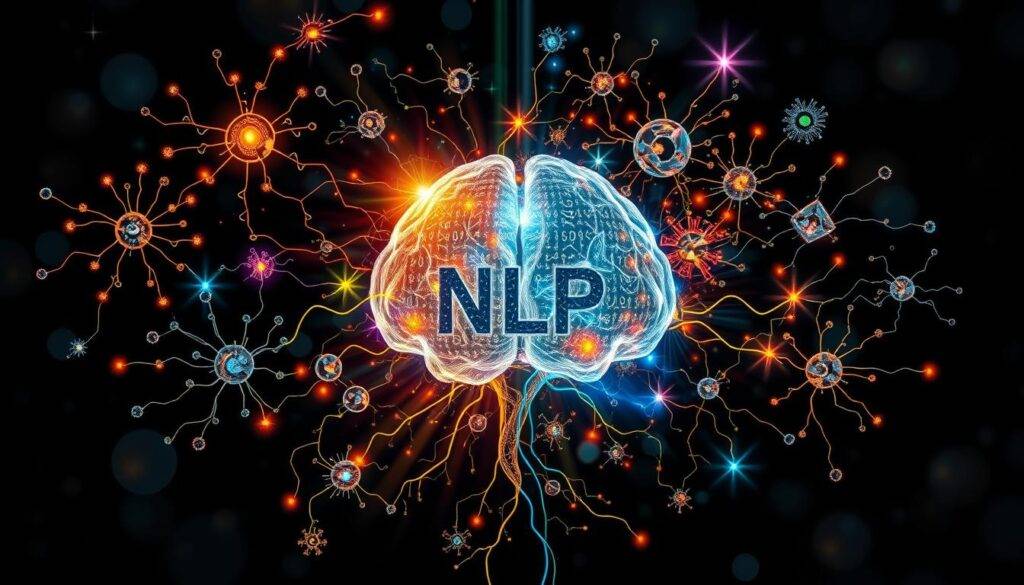“The greatest weapon against stress is our ability to choose one thought over another.” – William James
In today’s fast world, keeping our minds and hearts healthy is key. There’s a powerful way to do this – by combining modern psychology with ancient healing. By learning about the Science of Synergy, you’ll see how NLP, meditation, and affirmations can change your life. They help you think differently, stay strong, and reach your highest potential.
This article looks at how these powerful tools work together. You’ll find out how to use them to get better overall well-being. And how to make the most of your mind-body connection.
Key Takeaways
- Discover the power of integrating NLP, meditation, and affirmations for personal growth and mental wellness.
- Understand the evolution of psychological approaches and the importance of evidence-based integration.
- Explore the science behind the mind-body connection and the synergistic effects of combined practices.
- Learn how to implement a sustainable integrated practice routine and overcome common challenges.
- Uncover the long-term benefits of consistent practice, including physical, mental, and professional enhancements.
Understanding the Power of Integrated Practices in Modern Psychology
Modern psychology looks at human behavior from many angles. It tries to understand why we feel, think, and act the way we do. It focuses on mental health and uses many ways to help people heal.
Psychotherapy has grown to include things like cognitive behavioral therapy (CBT) and mindfulness. This makes it easier for more people to get help.
The Evolution of Psychological Approaches
Psychological methods have changed a lot over time. They’ve moved from just treating symptoms to understanding the whole person. Emergent Properties, Complex Systems, and working together across fields are key now. They help make mental health care better and more effective.
Breaking Down Mental Wellness Barriers
Psychotherapy now meets the needs of many people. It uses different methods like CBT and mindfulness. This helps people help themselves and change in lasting ways.
The Role of Evidence-Based Integration
Using proven methods is very important in psychology today. Research shows that mixing different approaches works best. This way, mental health care can be more personal and effective for everyone.
| Statistic | Value |
|---|---|
| Studies confirming character strengths across cultures | Over 700 |
| Spirituality defined as the search for or communion with the sacred | Approximately two-thirds of studies |
| Nursing curriculum with high levels of teamwork and evidence-based practice | 82% and 73% respectively |
| Faculty with only intermediate/some comfort in evidence-based practice | 52% |
| Faculty as novices in or uncomfortable with evidence-based practice content | 11% |
“The science of character strengths has surged in recent years with hundreds of studies, however, minimal attention has been given to the integration of character strengths and spirituality.”
The Science of Synergy: Exploring Mind-Body Connections
Ancient healing practices like Ayurveda and Traditional Chinese Medicine (TCM) show how body, mind, and spirit are connected. These holistic systems aim to balance energies and restore harmony. They also highlight the sacred bond between us and the universe, leading to deep self-discovery.
Research in Collective Intelligence and Systems Thinking reveals the deep connection between our minds and bodies. It shows that trauma, stress, and negative emotions can harm our health. This can lead to serious conditions like autoimmune disorders and cancer.
“Stress is linked to the risk of autoimmune disorders and cancer progression, with emotional stress reported by 80% of patients before the onset of certain diseases.”
On the other hand, meditation, yoga, and positive affirmations have shown great benefits. Studies have found these practices can lower stress, anxiety, and depression. They also improve flexibility, immune function, and overall health.
Understanding the link between our thoughts, emotions, and physical health opens up new possibilities. Adopting a holistic approach to growth and wellness can greatly improve our lives. It boosts our resilience and connection to the world.
Foundations of Neuro-Linguistic Programming (NLP)
Neuro-linguistic programming (NLP) is a powerful tool that links our brain, language, and actions. It helps us change negative thoughts into positive ones. This leads to personal growth and better emotional health.
At the heart of NLP is the idea that our words and thoughts shape our lives. This is a key part of NLP’s power.
Core NLP Principles and Techniques
NLP has many techniques to help us relax, dream big, and find our inner strength. These include visualizing, saying positive affirmations, and using anchors. They help boost self-confidence, build resilience, and bring about positive changes.
By changing how we think and talk to ourselves, we can overcome self-doubt. This opens up new opportunities for us.
The Language-Mind Connection
NLP shows how language affects our brain and well-being. Being mindful of our language helps us think and act better. This is a key part of NLP’s approach to growth and success.
Behavioral Pattern Recognition
NLP also teaches us to notice and understand patterns in ourselves and others. This skill improves our communication and helps us connect with people. It’s very useful in work, where being able to adapt and connect is key.
The Science of Synergy and Nonlinear Dynamics are important in NLP. They combine different psychological ideas to help us change deeply. By using NLP, we can become more aware, communicate better, and achieve our goals.

Ancient Wisdom Meets Modern Practice: Meditation Fundamentals
Meditation has deep roots in ancient traditions. It’s a powerful tool for mental and emotional health. It builds emotional strength and uses wisdom from many cultures.
When you mix meditation with Neuro-Linguistic Programming (NLP) and affirmations, the results are amazing. This mix creates a synergistic effect. It boosts the benefits of each practice, leading to personal growth.
Neuro-Meditation combines new science with old meditation techniques. It uses the brain’s pathways to reduce stress and find balance. Studies, like Zeidan et al.’s in “Psychological Science” (2010), back this up.
Guided imagery in Neuro-Meditation boosts brain connections and sharpens the mind. It references Eyre et al.’s work in the “Journal of Alzheimer’s Disease” (2016). Brainwave entrainment helps move from alertness to calm, making deep meditation easier.
Each Neuro-Meditation session is tailored to meet your needs. It improves focus, emotional health, or relaxation with soundscapes.
Pranayama, or breath control, is like the breathwork in Neuro-Meditation. Yoga asanas in Neuro-Yoga classes blend yogic wisdom with science. They help the brain adapt and grow, as studies show.
Pranayama in Neuro-Yoga calms the nervous system, reducing stress. Cramer et al.’s meta-analysis in “Psychoneuroendocrinology” (2017) supports this. Visualization in Neuro-Yoga boosts brain connections, as Eyre et al.’s study in the “Journal of Alzheimer’s Disease” (2016) shows.
Neuro-Meditation and Neuro-Yoga blend ancient wisdom with modern science. They offer a complete way to change yourself. They help you find synergistic interactions between your mind and body, leading to better well-being and resilience.
The Transformative Power of Affirmations
Affirmations are powerful in Complex Systems and Interdisciplinary Collaboration. They are positive statements that change our brain’s paths and life experiences. By using the law of attraction, affirmations help you think positively about success, abundance, and well-being.
Neural Pathways and Positive Self-Talk
Research in positive psychology shows affirmations can change our brain’s paths. This leads to better mental health, less stress, and more resilience. Positive self-talk rewires our brain to focus on our strengths and goals. This change greatly improves our well-being.
Creating Effective Affirmation Practices
To make good affirmations, they should be positive, clear, and in the present tense. They should reflect your personal goals and aspirations. Being thankful can also shift your focus to the positive, attracting more good things into your life.
Measuring Affirmation Impact
Using affirmations and gratitude together can have a strong effect. Morning affirmations can set a positive tone for the day. Bedtime reflection can help you appreciate the day’s good moments and learn from challenges.
| Affirmation Benefit | Impact |
|---|---|
| Rewiring Neural Pathways | Improved mental health, stress reduction, and enhanced resilience |
| Cultivating Positive Mindset | Increased self-confidence, self-esteem, and sense of abundance |
| Attracting Positive Experiences | Manifestation of desired goals, opportunities, and meaningful relationships |
| Synergy with Gratitude Practices | Amplified benefits in emotional well-being, life satisfaction, and personal growth |
Affirmations, when used with other mind-body practices, can start a journey of growth, happiness, and fulfillment. This powerful tool can bring amazing changes to your life. Start using affirmations and see the positive effects they can have.
Synergistic Effects of Combined Practices
Neuro-Linguistic Programming (NLP), meditation, and affirmations work together powerfully. They use the best of old and new ways to explore your subconscious mind. This leads to big emotional healing and self-discovery.
This mix of practices boosts the Emergent Properties of your mind-body connection. It unlocks a deep Collective Intelligence that goes beyond what each practice can do alone. It’s like a symphony, where each part adds its own special sound to create something beautiful and changing.
By using NLP, meditation, and affirmations together, you get a strong mix of strategies. This mix can have bigger and longer-lasting effects on your health than using just one method.
The Synergistic Effects of these practices show up in many ways. For example, NLP can make your affirmations more powerful. Meditation can also make you more open to the positive messages from affirmations. This creates a cycle that makes each practice even more effective.
In the end, combining NLP, meditation, and affirmations can change you in big ways. It helps you grow, become more emotionally strong, and feel better overall. By taking this holistic path, you start a journey of self-discovery and unlock your mind-body connection’s full potential.
Implementing an Integrated Practice Routine
To unlock the power of meditation, Neuro-Linguistic Programming (NLP), and affirmations, you need a good practice routine. By mixing these techniques, you can grow personally and improve your mental health. Let’s look at how to make a good practice schedule, track your progress, and adjust it for you.
Building a Sustainable Practice Schedule
Being consistent is key to a strong practice. Start with 10-15 minutes a day. Try guided meditations with NLP and positive affirmations. As you get better, make your practice longer and more complex.
Tracking Progress and Results
It’s important to watch your progress to stay motivated and adjust your practice. Keep a journal of your experiences and any changes you notice. Use apps or tools to see how your practice affects stress, focus, and well-being.
Adapting Techniques for Personal Success
Your practice is a personal journey. Feel free to try different techniques and change them to fit you. Reflect on what works best for you and adjust your routine. Make sure it stays interesting, challenging, and doable for a long time.
By using an integrated practice, you’ll grow in self-awareness, emotional strength, and personal fulfillment. Stick with it, and you’ll unlock your amazing potential.
Overcoming Common Integration Challenges
Integrating the Science of Synergy – combining practices like meditation, NLP, and affirmations – can be tough. But, with the right mindset and strategies, you can overcome these hurdles. This way, you unlock the full power of synergistic interactions.
One big challenge is maintaining consistency in your routine. Life’s ups and downs can throw off even the best plans. To beat this, add flexibility and make your practice sustainable, even when life gets busy.
- Try shorter, more frequent sessions to keep the momentum.
- Find daily trigger points to easily fit in your practices.
- Get support from friends or a community to stay on track.
Another challenge is balancing different techniques. Each practice, like meditation or affirmations, has its own pace. Find a harmony that suits you, rather than trying a one-size-fits-all approach.
- Set aside time for each practice based on what you need.
- Try creative ways to mix practices, like meditating with affirmations playing.
- Be patient as you find the right mix that works for you and supports Synergistic Interactions.
Dealing with skepticism and staying motivated at the start can be tough. Remember, everyone’s journey is different. What works for one might not work for another.
With education, support, and a flexible approach, you can overcome these challenges. Embrace the journey, celebrate small wins, and trust in your integrated practice. It will boost your well-being and personal growth.
“The journey of a thousand miles begins with a single step.” – Lao Tzu
Benefits of Long-Term Practice Integration
Mixing meditation, Neuro-Linguistic Programming (NLP), and positive affirmations can change your life for the better. These practices work together to improve your health and mind. They lead to deep changes in your life.
Physical and Mental Health Improvements
Practicing these methods regularly can lower your anxiety and boost your focus. It also makes you more creative. You’ll sleep better, have more energy, and a stronger immune system.
Enhanced Emotional Resilience
Meditation, NLP, and affirmations make you emotionally stronger. You’ll know yourself better and handle life’s challenges with ease. This helps you stay positive, build better relationships, and control your emotions.
Professional Performance Optimization
At work, using these practices can make you more productive and creative. You’ll solve problems better and make smart decisions. This leads to success in your career.
Together, meditation, NLP, and affirmations can transform your life. They help you grow and reach your full potential. Try this approach and see how it changes your life.

Conclusion
Modern psychology and ancient healing practices come together in a powerful way. This is through the use of meditation, NLP, and affirmations. They offer a strong path to personal growth and overall well-being. Research shows these methods work well together, opening doors for more studies and tools in mental health.
Using these practices together can help you understand the mind-body connection better. You can use your thoughts, feelings, and actions to make lasting positive changes. This approach can help you improve your mental clarity, emotional strength, or work performance.
Starting your journey of self-discovery and growth is exciting. Remember, the path to happiness is not always straightforward. These practices are flexible and adaptable, helping you grow and overcome obstacles. Embrace the power of working together and unlock your amazing potential.
FAQ
What is the intersection between modern psychology and ancient healing practices?
This article looks at how modern psychology meets ancient healing. It talks about techniques like NLP, meditation, and affirmations. It shows how these can help us grow and feel better overall.
How do modern psychology and ancient healing practices contribute to mental well-being?
Modern psychology gives us a wide view of human behavior. It stresses the need for a holistic approach to healing. Ancient practices like Ayurveda and Traditional Chinese Medicine focus on the connection between body, mind, and spirit.
What is the role of neuro-linguistic programming (NLP) in personal growth and emotional well-being?
NLP looks at how our brains, language, and actions are linked. It helps us change negative thoughts into positive ones. This can improve our self-esteem and help us deal with tough times.
How can the integration of meditation, NLP, and affirmations create a synergistic effect?
Combining NLP, meditation, and affirmations is powerful. It lets us dive deep into our subconscious. This can lead to big emotional breakthroughs and self-discovery.
What are the benefits of long-term practice integration?
Long-term use of these practices can greatly improve our health. It can lower anxiety, boost focus, and enhance creativity. It also helps us manage stress better and be more productive at work.
What are the common challenges in integrating multiple practices?
Mixing different practices can be tough. It’s hard to keep up and find the right mix. But, every person is different, and finding what works best for you is key. Overcoming doubts and staying motivated is also a challenge, but support can help.




























































